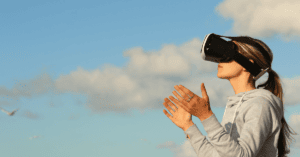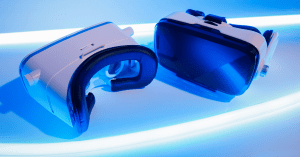
If you’re into virtual reality, you’ve probably heard about 360 cameras. You know they can produce immersive videos. However, you’re not quite sure how they work.
A 360 camera works by using two or multiple fisheye lenses that capture a wide-angle view. Then, the camera stitches these photos together into a 360° sphere.
Below, we’ll cover how a 360 camera works in more detail. We’ll also answer your questions about this particular device.
What Is a 360 Camera?

A 360 camera is a device that simultaneously captures images and videos in all directions. It creates a 360-degree angle of view, hence its name. It lets you record the surrounding environment in a single spherical image for an immersive experience.
It is popular for virtual reality (VR) content, virtual tours, and other interactive media (more on this topic later).
How Does a 360 Camera Work?
A 360 view camera system works by using multiple lenses to capture a spherical image. Each built-in lens covers a part of the scene because it is carefully arranged in a deliberate circle. That ultimately allows you to record photos from every angle at once for an unobstructed field of view.
Then, the internal software of the camera combines these individual images or videos into a seamless 360-degree frame. Viewers can freely explore this cohesive and continuous visual as if they were at the exact capture location.
What’s The Difference Between a 360 Camera And VR?

The terms “360 camera” and “VR” or “virtual reality” are often used interchangeably because of their similarities. However, they are not the same thing and have unique differences.
A 360-degree camera simply captures spherical images in a rectangular frame, so you can view any object from different angles. The resulting photo comes from real-life views that the camera system carefully stitched together.
In contrast, virtual reality is highly interactive. Not only can you view the objects, but you can also move and touch them. It feels like you are in an entirely new world at the moment. However, VR is not real. It is mostly a computer-generated image, unlike a traditional photo in 360 cameras.
Many people confuse 360 cameras with VR (and vice versa) because VR headsets often use 360-degree images and videos. These highly specialized devices simply put a 3D effect on the real-life objects for a true interactive experience.
What Are the Uses of a 360 Camera?

A 360 camera has many applications across different industries.
One of the most popular uses of a 360-degree camera is virtual tours. Think of museums, real estate properties, and tourist attractions. They utilize the wide-angle lenses of the camera system to capture a 360-degree view. They allow you to view the entire area without being physically in there.
A 360 camera also has a large following in social media. It helps you capture interesting footage that can go viral on Facebook and YouTube, among other social media platforms. Whether it’s vloggers filming themselves doing insane stunts or a tourist view of a tall building, this device is ideal for many people.
Documentation is another useful application of 360 cameras. Google Maps uses them to capture places in street view mode. In the photo example above, the camera is mounted on top of the car. Its built-in software creates a composite view of the vehicle and its surroundings. Crime scenes and construction sites also benefit from the immersive surroundings because you can see details in a 360-degree view.
Plus, a 360-degree camera can create interactive educational content to enhance learning experiences.
Finally, these special devices are useful in event and wedding photography. They can preserve your special images in an equirectangular projection.
How to Frame Your Shot With 360-Degree Cameras?
A 360-degree view camera system captures images that look cool. However, it can be a bit difficult and sounds complicated for the first time. So, we’ll share some tips below to help you achieve the perfect framing with these cameras.
First, remember that 360 cameras cover a lot of areas in a single picture. You’ll want to place the device high above you for the best results. Use a tripod, monopod, or a selfie stick to elevate the camera.
Next, observe your surroundings. Be mindful of the objects in front, behind, and to the sides of the camera. All of them will show up in the final image. We recommend placing the device at the center of the action or in a location where you can see a lot of interesting elements.
When capturing 360-degree pictures of landscapes, make sure the camera is level to the ground. If you’re using a tripod, you can refer to the built-in bubble level to know whether the device is straight or not. But if you only have a monopod or a selfie stick, consider putting a flag on top of a straight pole beside them. This will act as your reference for level ground.
Skip the previous step if you’ll film yourself. There’s no need to worry about keeping the camera straight and level to the ground. That said, always keep a third-person point of view in mind. Think of yourself as the main subject, and don’t be afraid to experiment with angles. Also, consider getting a self-timer activation device to capture images even if you cannot physically press the shutter button.
Finally, know the location of the stitching line. It is where the two or more lenses meet in a rectangle video format. The field of view can be slightly distorted when the camera combines the images. As such, try to move important elements away from the stitch line.
Conclusion
A 360 camera is a unique device that shows a 360-degree perspective of the surroundings. It automatically shoots a portion of the image by using two or multiple lenses. Then, the internal software combines the captured data into one seamless frame.
Do you have more questions about 360-degree cameras? Send your queries to our contact page!






